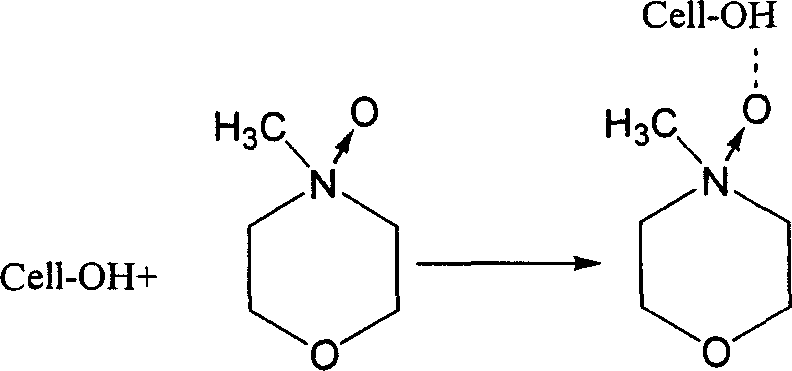Cellulose asymmetric hollow fiber ultrafiltration membranes and preparation method thereof
A cellulose and asymmetric technology, applied in chemical instruments and methods, membrane technology, semi-permeable membrane separation, etc., can solve the problems of weakened acid and alkali resistance, poor mechanical strength of cellulose, and destruction of natural characteristics of cellulose. Achieve high anti-pollution ability, simple method and process, and good chemical stability
- Summary
- Abstract
- Description
- Claims
- Application Information
AI Technical Summary
Problems solved by technology
Method used
Image
Examples
Embodiment 1
[0042] 32 grams of cellulose (average degree of polymerization ≈ 1000), 0.16 grams of propyl gallate (0.5% of cellulose weight), 16 grams of PEG400 (50% of cellulose weight) added 352 grams of NMMO H 2In O, stir at 95°C for 24 hours under the protection of nitrogen to dissolve completely. After vacuum defoaming, a casting solution with a cellulose concentration of 8% is obtained, and then put into a spinning tank for dry-wet spinning. The spinning temperature is 80°C, the dry spinning distance is 70mm, the core fluid is deionized water, and the core fluid flow rate is 0.8ml min -1 , the gel bath is water, and the temperature of the water bath is 50°C. The spun cellulose hollow fiber membrane was washed in flowing deionized water for 24 hours and placed in 50% glycerol aqueous solution for standby. The scanning electron microscope showed that the membrane was an asymmetric structure (see Fig. 1a, Fig. 1b), and the pure water flux of the membrane 7.68L·m -2 h -1 , bovine seru...
Embodiment 2
[0054] 38.3 grams of cellulose (average degree of polymerization ≈ 1000), 0.19 grams of propyl gallate (0.5% of the weight of cellulose) was added to 440 grams of NMMO·H 2 In O, stir at 90°C for 24 hours under the protection of nitrogen to completely dissolve. After vacuum defoaming, a casting solution with a cellulose concentration of 8% is obtained, which is put into a spinning tank for dry-wet spinning. The dry spinning distance is 50mm, the spinning temperature is 80°C, the core liquid is deionized water, and the flow rate is 0.8ml min -1 , the gel bath is water, and the temperature is 50°C. The spun cellulose hollow fiber membrane was washed in flowing deionized water for 24 hours, and then placed in 50% glycerol aqueous solution for use. After characterization, the pure water flux of the membrane is 5.26 L m -2 h -1 , The bovine serum albumin retention rate was 61%.
Embodiment 3
[0056] Add 42 g of cellulose (average degree of polymerization ≈ 1000), 0.2 g of propyl gallate to 480 g of NMMO·H 2 In O, stir at 95°C for 24 hours under the protection of nitrogen to dissolve completely. After vacuum defoaming, a casting solution with a cellulose concentration of 8% is obtained, which is put into a spinning tank for dry-wet spinning. The dry spinning distance is 100mm, the spinning temperature is 90°C, the core fluid is deionized water, and the flow rate is 0.6ml min -1 , the gel bath is water, and the temperature is 20°C. The spun cellulose hollow fiber membrane was washed in flowing deionized water for 24 hours, and then placed in 50% glycerol aqueous solution for use. After characterization, the pure water flux of the membrane is 4.89L m -2 h -1 , The bovine serum albumin rejection rate was 41%.
PUM
 Login to View More
Login to View More Abstract
Description
Claims
Application Information
 Login to View More
Login to View More - R&D
- Intellectual Property
- Life Sciences
- Materials
- Tech Scout
- Unparalleled Data Quality
- Higher Quality Content
- 60% Fewer Hallucinations
Browse by: Latest US Patents, China's latest patents, Technical Efficacy Thesaurus, Application Domain, Technology Topic, Popular Technical Reports.
© 2025 PatSnap. All rights reserved.Legal|Privacy policy|Modern Slavery Act Transparency Statement|Sitemap|About US| Contact US: help@patsnap.com



